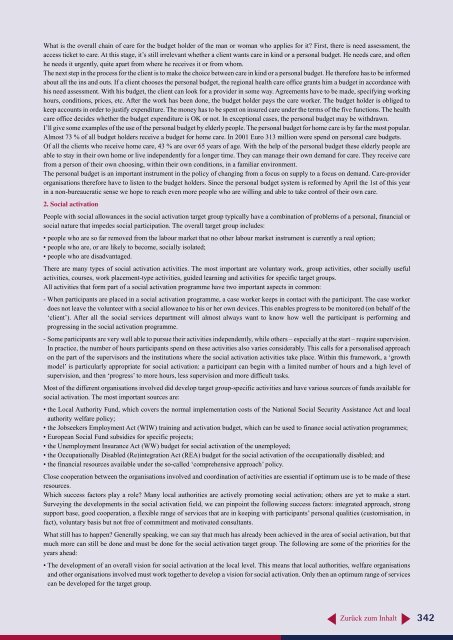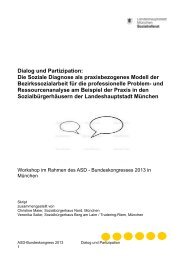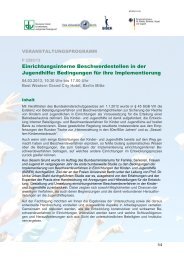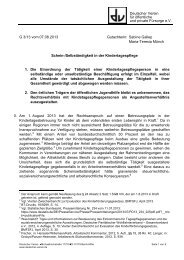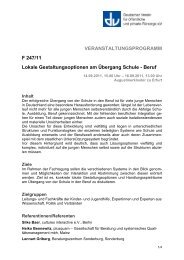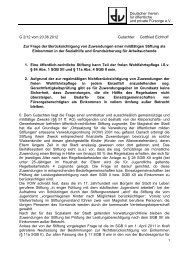Workshop 1.6 - Deutscher Verein für öffentliche und private Fürsorge
Workshop 1.6 - Deutscher Verein für öffentliche und private Fürsorge
Workshop 1.6 - Deutscher Verein für öffentliche und private Fürsorge
Erfolgreiche ePaper selbst erstellen
Machen Sie aus Ihren PDF Publikationen ein blätterbares Flipbook mit unserer einzigartigen Google optimierten e-Paper Software.
What is the overall chain of care for the budget holder of the man or woman who applies for it? First, there is need assessment, the<br />
access ticket to care. At this stage, it’s still irrelevant whether a client wants care in kind or a personal budget. He needs care, and often<br />
he needs it urgently, quite apart from where he receives it or from whom.<br />
The next step in the process for the client is to make the choice between care in kind or a personal budget. He therefore has to be informed<br />
about all the ins and outs. If a client chooses the personal budget, the regional health care office grants him a budget in accordance with<br />
his need assessment. With his budget, the client can look for a provider in some way. Agreements have to be made, specifying working<br />
hours, conditions, prices, etc. After the work has been done, the budget holder pays the care worker. The budget holder is obliged to<br />
keep accounts in order to justify expenditure. The money has to be spent on insured care <strong>und</strong>er the terms of the five functions. The health<br />
care office decides whether the budget expenditure is OK or not. In exceptional cases, the personal budget may be withdrawn.<br />
I’ll give some examples of the use of the personal budget by elderly people. The personal budget for home care is by far the most popular.<br />
Almost 73 % of all budget holders receive a budget for home care. In 2001 Euro 313 million were spend on personal care budgets.<br />
Of all the clients who receive home care, 43 % are over 65 years of age. With the help of the personal budget these elderly people are<br />
able to stay in their own home or live independently for a longer time. They can manage their own demand for care. They receive care<br />
from a person of their own choosing, within their own conditions, in a familiar environment.<br />
The personal budget is an important instrument in the policy of changing from a focus on supply to a focus on demand. Care-provider<br />
organisations therefore have to listen to the budget holders. Since the personal budget system is reformed by April the 1st of this year<br />
in a non-bureaucratic sense we hope to reach even more people who are willing and able to take control of their own care.<br />
2. Social activation<br />
People with social allowances in the social activation target group typically have a combination of problems of a personal, financial or<br />
social nature that impedes social participation. The overall target group includes:<br />
• people who are so far removed from the labour market that no other labour market instrument is currently a real option;<br />
• people who are, or are likely to become, socially isolated;<br />
• people who are disadvantaged.<br />
There are many types of social activation activities. The most important are voluntary work, group activities, other socially useful<br />
activities, courses, work placement-type activities, guided learning and activities for specific target groups.<br />
All activities that form part of a social activation programme have two important aspects in common:<br />
- When participants are placed in a social activation programme, a case worker keeps in contact with the participant. The case worker<br />
does not leave the volunteer with a social allowance to his or her own devices. This enables progress to be monitored (on behalf of the<br />
‘client’). After all the social services department will almost always want to know how well the participant is performing and<br />
progressing in the social activation programme.<br />
- Some participants are very well able to pursue their activities independently, while others – especially at the start – require supervision.<br />
In practice, the number of hours participants spend on these activities also varies considerably. This calls for a personalised approach<br />
on the part of the supervisors and the institutions where the social activation activities take place. Within this framework, a ‘growth<br />
model’ is particularly appropriate for social activation: a participant can begin with a limited number of hours and a high level of<br />
supervision, and then ‘progress’ to more hours, less supervision and more difficult tasks.<br />
Most of the different organisations involved did develop target group-specific activities and have various sources of f<strong>und</strong>s available for<br />
social activation. The most important sources are:<br />
• the Local Authority F<strong>und</strong>, which covers the normal implementation costs of the National Social Security Assistance Act and local<br />
authority welfare policy;<br />
• the Jobseekers Employment Act (WIW) training and activation budget, which can be used to finance social activation programmes;<br />
• European Social F<strong>und</strong> subsidies for specific projects;<br />
• the Unemployment Insurance Act (WW) budget for social activation of the unemployed;<br />
• the Occupationally Disabled (Re)integration Act (REA) budget for the social activation of the occupationally disabled; and<br />
• the financial resources available <strong>und</strong>er the so-called ‘comprehensive approach’ policy.<br />
Close cooperation between the organisations involved and coordination of activities are essential if optimum use is to be made of these<br />
resources.<br />
Which success factors play a role? Many local authorities are actively promoting social activation; others are yet to make a start.<br />
Surveying the developments in the social activation field, we can pinpoint the following success factors: integrated approach, strong<br />
support base, good cooperation, a flexible range of services that are in keeping with participants’ personal qualities (customisation, in<br />
fact), voluntary basis but not free of commitment and motivated consultants.<br />
What still has to happen? Generally speaking, we can say that much has already been achieved in the area of social activation, but that<br />
much more can still be done and must be done for the social activation target group. The following are some of the priorities for the<br />
years ahead:<br />
• The development of an overall vision for social activation at the local level. This means that local authorities, welfare organisations<br />
and other organisations involved must work together to develop a vision for social activation. Only then an optimum range of services<br />
can be developed for the target group.<br />
Zurück zum Inhalt<br />
342


